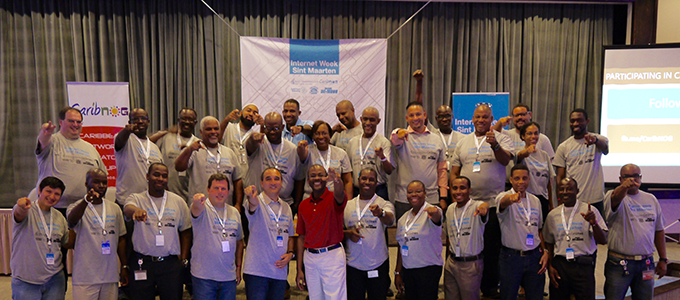LACNIC goes all in on Caribbean development
25/11/2016

By Gerard Best
When the regional technical community gathered in Sint Maarten on October 27 to 28 to lend their collective strength to developing the Caribbean Internet, LACNIC was at the very forefront.
Called Sint Maarten on the Move, the two-day event brought together a diverse profile of Caribbean stakeholders, including government officials, policy makers, industry regulators, network engineers, academic researchers, regional journalists and ordinary Internet users.
“I personally find the Caribbean region fascinating,” said LACNIC Chief Technology Officer Carlos Martinez, “because of the unique technical challenges that it faces.”
Caribbean islands are historically prone to natural disasters such as devastating weather and seismic events. The region’s ethnographic and cultural diversity stems in part from its economic and linguistic history involving European colonization, African slavery, Asian indentureship and North American cultural domination. It’s also a geopolitical rarity: an archipelago of sparsely populated sovereign territories connected by common history yet divided by the Caribbean Sea.
“The interconnectivity between the islands presents several challenges that are not found in other places. I think it brings out the best of people in order to overcome those challenges,” Martinez observed.
And the Caribbean has been one of LACNIC’s focused areas of investment, in terms of training and capacity building. Sint Maarten on the Move was only the latest installation in an ongoing LACNIC on the Move series, which aims to increase awareness and develop capacity and in a range of areas including Internet exchange points and cyber security in Central America and the Caribbean.
“We believe that LACNIC has a responsibility to the region, and we are trying our best to fulfill that,” Martinez said.
It is a responsibility shared with the American Registry of Internet Numbers, LACNIC’s counterpart in North and Central America and the Caribbean. Mark Kosters, Chief Technology Officer of ARIN, echoed Martinez’s commitment to pursuing Caribbean technology development.
However, Kosters underscored that Caribbean Internet users had a responsibility of their own, when it comes to mitigating cyber attack risk. Citing the example of recent attacks against companies providing critical Internet services, the ARIN CTO explained that end-users have to become increasingly security-aware as the Internet of Things, or IoT, continues to expand.
The Caribbean, though better known for its sun-washed sandy beaches, is hardly immune to the security risk posed by IoT growth, as consumers in that market are rapidly adding to the global network of Internet-connected devices.
“As smart devices proliferate, it will become easier for hackers to launch significant cyber attacks using unsecured IoT devices, unless ordinary end-users become more security-conscious,” Martinez chimed in.
The message was underscored by the Internet Society, which jointly hosted the Sint Maarten meeting. Shernon Osepa, ISOC Regional Affairs Manager for Latin America and the Caribbean, gave an overview of regional initiatives aimed at reducing risk and responding to cyber incidents.
Through initiatives like Sint Maarten on the Move, LACNIC is tapping into a symbiotic relationship with the region. On one hand, it is finding new ways to connect directly with its Caribbean members. For example, Kevon Swift, Head of Strategic Relations and Integration at LACNIC, gave participants in Sint Maarten a crash course on Internet Governance, providing an overview of the roles of key players in the regional and international landscape. And Sergio Rojas, LACNIC Registry Services Specialist, spent some time demystifying LACNIC’s core services and Policy Development Process.
On the other hand, LACNIC is also contributing more directly to an important shift in the dialogue among the regional technical community. The collective push by LACNIC and other regional bodies to increase awareness of Internet-related issues is changing the buzz among the architects of the Caribbean’s digital future. The conversation is evolving beyond critical infrastructure.
“We have to look beyond basic infrastructure deployment, to developing the local content, services and business models that can truly benefit the region,” said Bevil Wooding, Internet Strategist with US-based non-profit Packet Clearing House.
“The private sector, academia and governments all have to work in sync to create opportunities for digital innovators and entrepreneurs to take advantage of the Internet and build on the local IXPs that now exist. We have to actively build the Caribbean cloud.”
Wooding, a longstanding champion of regional development, co-presented on an Internet Exchange Points panel discussion that included Eldert Louisa, chairman of the Open Caribbean Internet Exchange and Chief Technical Officer of Sint Maarten telecom operator TelEm Group.
Sint Maarten on the Move was part of Internet Week Sint Maarten, a five-day conference coordinated by the St Maarten telecommunications regulator, BTP. Held at the Sonesta Great Bay Resort in Philipsburg, the weeklong event also covered important topics such as Internet Governance, IPv6 transition and net neutrality.
The Caribbean Network Operators Group and the Internet Corporation for Assigned Names and Numbers jointly kickstarted the week with CaribNOG’s twelfth regional meeting and ICANN’s LAC-I Roadshow, from October 24 to 26.
“At CaribNOG 12, our principal aim was to foster dialogue with the Sint Maarten and Caribbean Internet community about the global Internet ecosystem,” said Wooding, who is also the co-founder of CaribNOG.
Albert Daniels, Manager of Stakeholder Engagement for the Caribbean at ICANN, explained that the LAC-I Roadshow aimed “to raise awareness across the Latin America and Caribbean region on key topics related to the critical Internet infrastructure, security, stability and growth.”
The three-day gathering was supported by ArkiTechs, Packet Clearing House, the Caribbean Telecommunications Union and the American Registry for Internet Numbers.
(Free access, no subscription required)